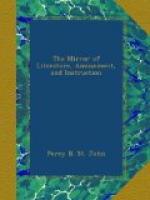“Pancras Church,” says Norden, “standeth all alone, as utterly forsaken, old and wether-beten, which, for the antiquity thereof, it is thought not to yield to Paules in London.” It is of rude Gothic architecture, built of stones and flints, which are now covered with plaster. Mr. Lysons says, “It is certainly not older than the fourteenth century, perhaps in Norden’s time it had the appearance of great decay; the same building, nevertheless, repaired from time to time, still remains; looks no longer ‘old and wether-beten,’ and may still exist perhaps to be spoken of by some antiquary of a future century. It is a very small structure, consisting only of a nave and chancel; at the west end is a low tower, with a kind of dome."[5] Mr. Lysons speaks of the disproportionate size of the church to the population of the parish; but since his time another church has been erected, the splendour and size of which in every respect accord with the increased wealth and numbers of the parish.
[5] The visitation of the
church in the year 1251, mentions a
very small tower, a good slope
font, and a small marble stone
ornamented with copper to
carry the Pax.
The church and churchyard of Pancras have long been noted as the burial-place of such Roman Catholics as die in London and its vicinity.[6] Many of the tombs exhibit a cross, and the initials R.I.P. (Requiescat in pace), which initials, or others analogous to them, are always used by the Catholics on their sepulchral monuments. Mr. Lysons heard it assigned by some of that persuasion, as a reason for this preference to Pancras as a burial-place, that masses were formerly said in a church in the south of France, dedicated to the same saint, for the souls of the deceased interred at St. Pancras in England. After the French revolution, a great number of ecclesiastics and other refugees, some of them of high rank, were buried in this churchyard; and in 1811, Mr. Lysons observed that probably about 30 of the French clergy had on an average been buried at Pancras for some years past: in 1801 there were 41, and in 1802, 32. Mr. Lysons’s explanation of this preference to Pancras by the Catholics is, however, disputed by the author of Ecclesiastical Topography, who observes that a reason more generally given is, that “Pancras was the last church in England where mass was performed after the Reformation.”
[6] Strype, in his additions
to Stowe, says, the Roman Catholics
have of late effected
to be buried at this place.
In the chancel are monuments of Daniel Clarke, Esq. who had been master-cook to Queen Elizabeth; and of Cooper the artist, whose style approached so near to that of Vandyke, that he has been called Vandyke in miniature: he taught the author of Hudibras to paint; his wife was sister to Pope’s mother.




